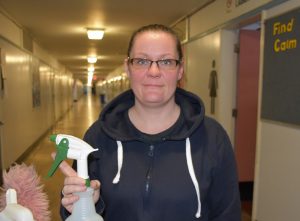 NEW WESTMINSTER—CUPE 409 President Marcel Marsolais said that reinstating daytime custodians during the COVID-19 pandemic underscores the important work they do, not only for those attending or working at child care learning centres in schools, but for everyone.
NEW WESTMINSTER—CUPE 409 President Marcel Marsolais said that reinstating daytime custodians during the COVID-19 pandemic underscores the important work they do, not only for those attending or working at child care learning centres in schools, but for everyone.
“Custodians are the unsung protectors of the K-12 sector,” said Marsolais. “They are integral in keeping schools healthy and safe for all students, including vulnerable children, and our staff. Now they also support the children of health care and other essential front-line workers in schools.”
Custodians are well-trained in the procedures and protocols developed by districts to keep schools safe. Front-line staff, including clerical support staff, monitor who is coming into each school, where they are and when then leave. Custodians then clean and disinfect areas that have been used so they are safe for the next set of users. They regularly disinfect desks and high-use surfaces.
Daytime custodians have always taken care of students and staff in schools. As well as cleaning desks, bannisters, railings and door handles, they also clean and maintain washrooms; empty garbage; patrol and pick up broken glass and dangerous debris from the school grounds; and help with school functions like assemblies.
Marsolais notes that custodians who work while school is in session provide an educational benefit to students and help build respect for ensuring students’ learning environments are safe and secure.
“I’ll bet most people can remember the name of their custodian when they went to school,” says Marsolais. “Kids build relationships with their school custodians.”
As schools gradually open, custodial work will be increasingly important in each district as more students and staff return.
“The bottom line is that custodians need to be in schools during this pandemic and need to be kept there whenever schools are in session,” said Marsolais.
“Union lobbies for return of daytime custodians in New West schools”, Julie MacLellan, New Westminster Record, April 30, 2020.
“Are BC Schools Clean Enough to Reopen?”, Katie Hyslop, The Tyee, May 4, 2020.

 NEW WESTMINSTER—CUPE 409 President Marcel Marsolais said that reinstating daytime custodians during the COVID-19 pandemic underscores the important work they do, not only for those attending or working at child care learning centres in schools, but for everyone.
NEW WESTMINSTER—CUPE 409 President Marcel Marsolais said that reinstating daytime custodians during the COVID-19 pandemic underscores the important work they do, not only for those attending or working at child care learning centres in schools, but for everyone. VICTORIA—Dr. Bonnie Henry speaks to educators and support staff about physical distancing in schools in a
VICTORIA—Dr. Bonnie Henry speaks to educators and support staff about physical distancing in schools in a